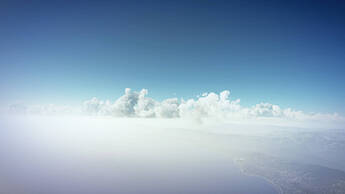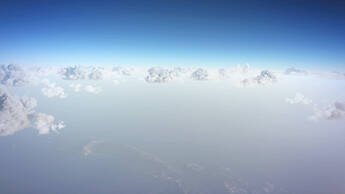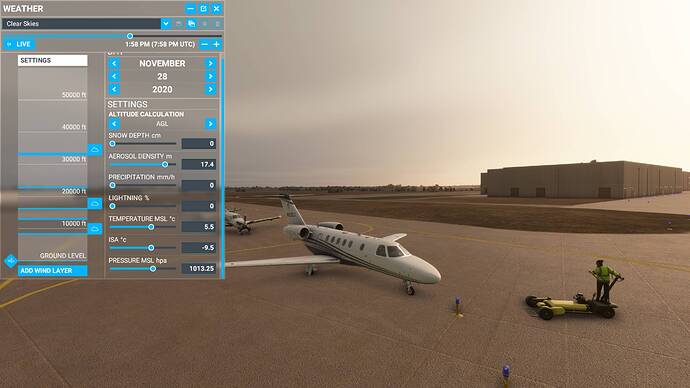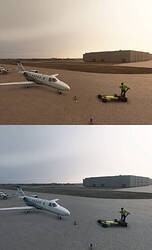I do think that aerosol has a lot to do with realistic simulation of reduced visibility. Right now the aerosol density by layer is not implemented in the live weather but it’s effect can be tested through custom weather. As it does in real life the aerosol density changes the color temperature of daylight, but IRL, our eyes adapt and so does a camera. If you live color correct (via nVidia game filters, color temperature and exposure option) your custom weather with the appropriate cloud layers and aerosol density, you can get skies looking like the examples in the first post.
I wish aerosol density per layer could be part of live weather.
Yes, absolutely. Here is what is needed:
-
To get visibility and visuals right we need to be able to set and adjust aerosol density per layer, seamlessly all the way from completely clear to what is essentially the inside of a cloud. Adjusting aerosol density per layer is what allows us to model the effect of an inversion layer trapping pollutants and other aerosols below a particular altitude.
-
To make use of the visibility reduction for IFR training we also need a readout of the resulting visibility due to the aerosol density.
-
To get visuals right we also need to adjust aerosol particle size. That is what makes mist, haze, maritime aerosols (like salt), and smoke look so different.
-
Finally, to make good use of this in the sim it needs to be included in the Live weather data.
Those four things are urgently needed in the MSFS weather model.
It’s already been addressed from the Q@A what they will do.
Don’t think so.
I wish they dropped the term aersol, I know it sounds fancy but just call it visibility thats what they mean by it anyway. Also it only changes the relative humidity of the air and not any solid particles as smoke, haze, sand etc.
In the weather menu use absolute values for RVR / visibility in meters, km, miles whatever and job done 
 .
.
The aerosol simulated in the sim is definitely solid particles, not water. Look at the attached screenshot: It is set up with a couple thick overcast cloud layers and a high aerosol setting, and the sun is just out of the view to the right.
It looks nothing like mist (water droplets), which is gray/white. It has a distinct yellow tint. It looks very similar to the light yellow skies we get here in northern California in the summer and fall when distant forest fires are blowing smoke our way (not the bright orange stuff we had a few months ago from exceptionally large fires).
Pretty good simulation of wavelength dependent Rayleigh scattering from tiny solid aerosol particles. Nothing like wavelength independent Mie scattering from water droplets.
Hmm maybe you are right, I have to say I don’t ever use that slider, I know it doesn’t go below 3 km visibility anyway so its pretty useless.
So we don’t have any option to adjust relative humidity at this point except placing the cloud deck and ground level? 
Still waiting for the option to accurately adjust visibility to 550 m RVR with a solid cloud deck at 200 ft or something for a proper ILS approach…
Yeah I really wish it simulated mist instead! That would seem a lot more useful, I cannot stand that yellow haze, but that is of course just my personal preference… Looks ok at very low settings to simulate pollution, but just for visuals…
People can vote here btw:
About the color, I said in my first reply, a sky with a lowered visibility needs to be color corrected in the sim and that is because the render engine is quite physically accurate in term of color temperature and does not apply color correction. In the real world, our eyes adapt to color changes but those changes do occur.
Increasing the light scattering either by increasing water droplet/water crystal density or aerosol (dust, sand, salt, diesel particles…) will always shift the color temperature of the “sky light dome” to a warmer color temperature.
When I fly in overcast conditions or foggy condition (I do get those in live weather and with very very low visibility range), I quickly adjust the color temperature of the render via nVidia game filters in order to get a neutral gray fog as my eyes would feel IRL.
@PierrePhot68 thank you for bringing up this point, I never related the settings but it might be in fact what is causing the improper white-balance.
The UserCfg.opt file has a ColorGrading post-processing effect you can disable.
Graphics Settings are saved in a json file here:
Store Version:
C:\Users\your_login_name\AppData\Local\Packages\Microsoft.FlightSimulator_#############\LocalCache\UserCfg.opt
Steam Version:
C:\Users\your_login_name\AppData\Roaming\Microsoft Flight Simulator\UserCfg.opt
The ColorGrading post-processing will not change the white balance, it only affects the RGB curve of the render: with ColorGrading 0 the tonal rendition is more linear you will have less contrast and less color saturation. I am French, I am not sure if it is the correct word, but I would say the render will have a “flat” look, which is often more realistic and gives room for your own grading with your own live game filters or while video editing in post production.
It is interesting to note that without ColorGrading, you reduce the contrast and it helps the effect of decreasing visibility by haze or fog. In the mean time, the flat picture gives you more dynamic range and helps you to find your way in a dark environment at dusk or dawn…
Adjusting the white balance is something else. If I tried to adjust the white balance of the picture posted above, I think I would like to have something like that:
This topic was automatically closed 30 days after the last reply. New replies are no longer allowed.




